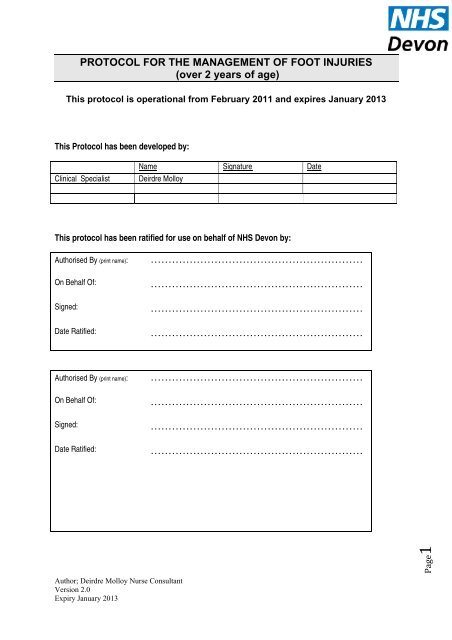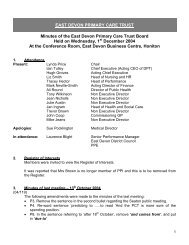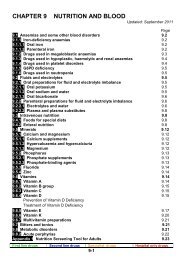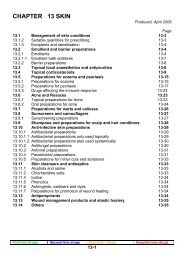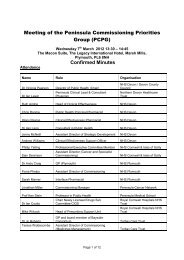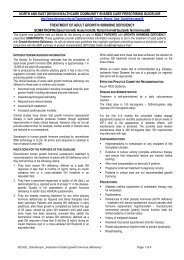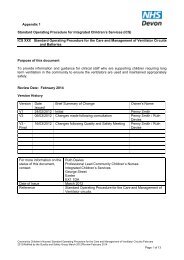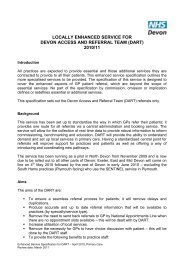PROTOCOL FOR THE MANAGEMENT OF FOOT ... - NHS Devon
PROTOCOL FOR THE MANAGEMENT OF FOOT ... - NHS Devon
PROTOCOL FOR THE MANAGEMENT OF FOOT ... - NHS Devon
Create successful ePaper yourself
Turn your PDF publications into a flip-book with our unique Google optimized e-Paper software.
<strong>PROTOCOL</strong> <strong>FOR</strong> <strong>THE</strong> <strong>MANAGEMENT</strong> <strong>OF</strong> <strong>FOOT</strong> INJURIES<br />
(over 2 years of age)<br />
This protocol is operational from February 2011 and expires January 2013<br />
This Protocol has been developed by:<br />
Name Signature Date<br />
Clinical Specialist Deirdre Molloy<br />
This protocol has been ratified for use on behalf of <strong>NHS</strong> <strong>Devon</strong> by:<br />
Authorised By (print name): ……………………………………………………<br />
On Behalf Of: ……………………………………………………<br />
Signed: ……………………………………………………<br />
Date Ratified: ……………………………………………………<br />
Authorised By (print name): ……………………………………………………<br />
On Behalf Of: ……………………………………………………<br />
Signed: ……………………………………………………<br />
Date Ratified: ……………………………………………………<br />
Author; Deirdre Molloy Nurse Consultant<br />
Version 2.0<br />
Expiry January 2013<br />
Page1
<strong>PROTOCOL</strong> <strong>FOR</strong> <strong>THE</strong> <strong>MANAGEMENT</strong> <strong>OF</strong> <strong>FOOT</strong> INJURIES (over 2 years of<br />
age)<br />
This protocol is for the use by staff employed by <strong>NHS</strong> <strong>Devon</strong> and has achieved the<br />
agreed clinical competencies to work under this protocol.<br />
Author; Deirdre Molloy Nurse Consultant<br />
Version 2.0<br />
Expiry January 2013<br />
PRESENTING SYMPTOMS<br />
Swelling Bruising/redness Deformity/dislocation<br />
Pain Wounds Heat/inflammation<br />
Reduced/Loss of function Difficulty/Inability to weight bear<br />
HISTORY<br />
History: refer to protocol for History Taking and Clinical Documentation and protocol for the Management<br />
of Limb Injuries.<br />
Specific:<br />
• Establish when, where and how the injury occurred.<br />
• Establish the exact mechanism, e.g. inversion or eversion. Was there a fall from a height? Crush<br />
injury?<br />
• Ask whether the patient could weight bear immediately after the injury<br />
• A ‘crack’ felt or heard does not necessarily indicate a fracture<br />
• Was there immediate swelling to the injured limb.<br />
• Pain score at time of injury and on presentation<br />
• First aid treatment received.<br />
• The amount of swelling may depend on whether ice and elevation have been applied<br />
• The amount of pain on examination may depend on whether analgesia has been taken<br />
• Past medical history including previous injuries to effected limb.<br />
• Medication<br />
• Allergies<br />
Refer all patients on Warfarin for further medical review/advice.<br />
Page2
CLINICAL EXAMINATION<br />
Observe where possible patients gait, balance, mobility, ability to weight bear<br />
Look<br />
• Symmetry<br />
• Deformity/dislocations<br />
• Swelling.<br />
• Bruising/discoloration,<br />
• Wounds/grazing<br />
Feel: (palpate from knee down)<br />
Note any tenderness over:<br />
• Calcaneum<br />
• Talus, navicular, cuboid, cuneiforms<br />
• Metatarsal bones1 – 5<br />
• Base of 5 th metatarsal<br />
• Phalanges<br />
Exclude tenderness to<br />
• Proximal fibula<br />
• Tibia and fibular shaft<br />
• Lateral malleolus and ligaments, including the anterior talofibular ligament<br />
• Medial malleolus and deltoid ligament<br />
Move<br />
• Inversion/eversion<br />
• Dorsi/planter flexion<br />
• Internal/external rotation<br />
• Flexion/extension of toes.<br />
• Ability to weight bear<br />
Special tests<br />
• Sensation/circulation<br />
• Anterior draw test (Gently pull the foot forward on the tibia to test for Anterior/posterior laxity<br />
Of the anterior talofibular ligament)<br />
• Achilles tendon: Simmons/Thomson test<br />
• Talar tilt test (Gently invert the ankle, if tolerable, to test for laxity of the whole lateral ligament<br />
complex)<br />
Interpreting Radiographs:<br />
• Request ankle or foot views using the Ottawa ankle/foot rule below<br />
• Fractures are usually obvious, but may only be seen on one view<br />
• If one fracture is seen, look carefully for another fracture or joint space widening<br />
Accessory ossicles adjacent to the tips of the medial and lateral malleoli are common – as are fracture fragments.<br />
A larger accessory ossicle, the os trigonum, is sometimes seen at the back of the talus on Lateral view.<br />
Clinical correlation is important. In addition, and accessory ossicle has a well defined<br />
(I.e. sclerotic) outline; a fracture fragment is usually ill defined on one of its sides<br />
Ankle Anterior/posterior mortice view:<br />
• The joint space should be uniform all the way around. Widening of the medial joint space indicates damage to the medial<br />
ligament<br />
• Look for a small bone fragment within the joint or a defect in the cortex of the talus, which indicates an osteochondral<br />
fracture<br />
• Inspect the lateral and medial malleoli<br />
Author; Deirdre Molloy Nurse Consultant<br />
Lateral view:<br />
Version 2.0<br />
• Inspect<br />
Expiry<br />
the lateral<br />
January<br />
and<br />
2013<br />
medial malleoli, and the posterior aspect of the tibia<br />
Inspect the calcaneum, as well as the navicular and base of 5 th metacarpal if shown<br />
3<br />
Page
The Ottawa Ankle Rule<br />
• The rule avoids unnecessary X-rays by identifying patients likely to have significant ankle fractures<br />
• It has almost 100% specificity for clinically significant fractures, and can save up to 40% of X-rays<br />
• It is based on assessment of the ability to bear weight (four steps), and the areas of bony tenderness<br />
• It applies to children and adults presenting with acute (within 10 days) ankle injuries<br />
The Ottawa Ankle Rule<br />
1. A 2-view ankle series (Anterior/posterior (AP) and lateral) is required only if there is any pain in the malleolar<br />
zone and any of the following:<br />
• Bone tenderness at A, the posterior edge or tip of the lateral malleolus<br />
• Bone tenderness at B, the posterior edge or tip of the medial malleolus<br />
• Inability to bear weight both immediately and in the Emergency Department<br />
2. A 3-view foot series (Anterior/posterior (AP), oblique and lateral) is required only if there is pain in the midfoot<br />
zone and any of the following:<br />
• Bone tenderness at D, the navicular<br />
Inability to bear weight both immediately and in the Emergency Department<br />
3. A 2-view foot series (Anterior/posterior (AP) and oblique) is required only if there is any pain in the midfoot zone<br />
and:<br />
• Bone tenderness at C, the base of the fifth metatarsal<br />
Note:<br />
• Allow a lower threshold for radiography in the very young, the elderly, those who are difficult to assess (e.g.<br />
intoxication, learning difficulties, stroke, presence of other injuries), and after injury from violent mechanism, (e.g.<br />
fall from a height, road traffic collision).<br />
• The rule does not apply to heel injuries e.g. fall from a height. These must be assessed independently with<br />
calcaneal views if relevant history and local tenderness.<br />
Mid/Fore foot: Injuries to mid/forefoot require AP and oblique views where bony tenderness identified<br />
Always request a true lateral view as well as AP and oblique if there is navicular tenderness or malalignment<br />
is suspected<br />
Calcaneal Au views: thor; Deirdre required Molloy where Nurse tenderness Consultant of calcaneal identified or clear history of significant calcaneal injury.<br />
• In the lateral Version and 2.0 axial views most displaced fractures are obvious<br />
• For subtle<br />
Expiry<br />
fractures<br />
January<br />
scrutinise<br />
2013<br />
carefully both views for breaks in the cortex or trabeculae<br />
• A sclerotic line in the body of the calcaneum suggests an impacted fracture<br />
• Some subtle compression fractures will only become apparent when Bohler’s angle is assessed:<br />
4<br />
Page
REFERRAL PATHWAY<br />
Calcaneal Fractures<br />
Specific history<br />
• Usually follow a fall from a height but may be caused by a twisting injury. Examine the calcaneum<br />
in all ankle injuries<br />
Clinical Examination: Refer to foot and ankle examination.<br />
• Look for swelling, bruising and tenderness over the heel and sides of the calcaneum<br />
• In major fractures the heel appears flattened and tilted laterally<br />
• Test the Achilles tendon (see Achilles Tendon Rupture)<br />
• After falls from a height look for associated injuries of the other ankle and heel, cervical and lumbar<br />
spine, pelvis, hips and knees.<br />
Refer to Orthopaedics – treat as advised by orthopaedics prior to transfer<br />
Talar fracture (displaced/undisplaced<br />
• Commonly from forced ankle dorsiflexion (e.g. against car pedal in a RTA), or a fall from a height<br />
• Displaced fractures disrupt the blood supply to the bone and frequently result in avascular necrosis.<br />
Skin necrosis and open fracture also occur (emergency referral)<br />
• Early reduction is imperative to minimise complications – seek emergency advice from Emergency<br />
Consultant whilst awaiting ambulance<br />
Talar Dome Fracture<br />
• In the ankle AP view a portion of the upper articular surface of the talus is seen to have sheared<br />
off, and occasionally is inverted and unable to unite. Refer to Orthopaedics,<br />
• Refer to Orthopaedics – treat as advised by orthopaedics prior to transfer<br />
SUBTALAR AND MID<strong>FOOT</strong> DISLOCATIONS<br />
• Follow violent twisting, inverting or everting injuries of the foot<br />
• Subtalar dislocation may be peritalar between the talus and calcaneum, or an isolated dislocation<br />
of the talus<br />
• Midtarsal dislocations involve the talus and calcaneum posteriorly and the navicular and cuboid<br />
anteriorly<br />
• Urgent reduction under general anaesthetic is required to minimise damage to skin and circulation<br />
Refer as Emergency to Orthopaedics via Emergency department, Adequate analgesia, elevation,<br />
monitor neurovascular integrity whilst awaiting ambulance.<br />
Navicular body fracture<br />
• Fractures of the body or widely displaced fragments may require accurate surgical reduction<br />
• Analgesia, elevate and refer to the Orthopaedics<br />
TARSOMETATARSAL (LISFRANC) DISLOCATION<br />
• There is disruption of one or more of the joints, usually with associated fracture of the metatarsal,<br />
cuboid or cuneiform bones<br />
• Prompt reduction is necessary because of the risks of swelling, circulatory impairment (especially<br />
dorsalis pedis) and compartment syndrome<br />
Refer directly to orthopaedics - treat as advised by orthopaedics prior to transfer monitoring<br />
neurovascular status<br />
1 st Metatarsal fracture<br />
• Refer to Orthopaedics - treat as advised by orthopaedics prior to transfer<br />
Displaced Author; or multiple Deirdre metatarsal Molloy Nurse fractures Consultant<br />
• Analgesia, Version 2.0 elevation, refer to the Orthopaedic team - treat as advised by orthopaedics prior to<br />
transfer Expiry January 2013<br />
D<br />
I<br />
S<br />
C<br />
H<br />
A<br />
R<br />
G<br />
E<br />
P<br />
A<br />
T<br />
H<br />
W<br />
A<br />
Y<br />
Page5
Treatment pathway<br />
Talar minor Avulsion Fractures: May result from ankle injuries.<br />
Treatment<br />
• Treat as for ankle sprain (see management of ankle injury and lower leg protocol) – may require<br />
Emergency Department or orthopaedic opinion<br />
Mid Foot Avulsion Fractures<br />
Avulsions of the navicular and cuboid may be part of an ankle sprain, e.g. the tuberosity of the navicular<br />
may be fractured by avulsion of tibialis posterior.<br />
Treatment – may require Emergency Department or Orthopaedic opinion<br />
• Analgesia as per patient group direction or advise on Over the counter analgesia e.g. NSAID’s<br />
and/or paracetomol.<br />
• Rest/elevation.<br />
• Support bandage. Crutches<br />
• Fracture clinic follow up.<br />
Undisplaced metatarsal fractures<br />
Treatment<br />
• Analgesia as per patient group direction. Or advise on Over the counter analgesia e.g. NSAID’s<br />
and/or paracetomol.<br />
• Rest and elevation.<br />
• Support bandage. Crutches<br />
• Fracture clinic follow up.<br />
Avulsion Fracture of the 5 th metatarsal base<br />
Following inversion of the ankle the peroneus brevis may avulse its bony attachment.<br />
Treatment<br />
• As for sprained ankle. – refer to management of ankle and lower leg protocol<br />
• Fracture clinic follow up.<br />
• Crutches<br />
• Pop is may be required if patient is in significant pain.<br />
Metatarsal Stress fractures<br />
• A fatique fracture, usually of the second metatarsal neck or shaft.<br />
• There may be localised tenderness or pain on longitudinal compression of the bone.<br />
• Initial radiographs may be normal and the diagnosis is made clinically<br />
• Callus or periosteal reaction will be seen at 2-3 weeks.<br />
Treatment<br />
• Analgesia as per patient group direction. Advice Over the counter analgesia.<br />
• Rest, modify daily activity as required.<br />
• Consider a padded insole or plaster of paris for pain relief.<br />
• Fracture clinic follow up.<br />
Toe Injuries Radiography<br />
• Apart from Hallux, most isolated toe injuries do not require radiography.<br />
• X-ray only if there is obvious deformity, gross swelling, suspected dislocation, compound injury,<br />
or MTPJ tenderness.<br />
•<br />
Hallux Fractures<br />
Usually from a heavy weight falling on an unprotected foot.<br />
May involve Author; the Deirdre IP joint Molloy and may Nurse be Consultant open<br />
Treatment Version<br />
2.0<br />
• Expiry Haematoma January present 2013 -trephine nail as necessary, or remove if virtually separated.<br />
• Treat open fracture with wound toilet under LA digital block<br />
• Antibiotic prophylaxis according to patient group direction.<br />
• Tetanus prophylaxis according to patient group direction<br />
• Proximal phalanx fractures may require toe spica or a walking plaster with toe platform for pain<br />
D<br />
I<br />
S<br />
C<br />
H<br />
A<br />
R<br />
G<br />
E<br />
P<br />
A<br />
T<br />
H<br />
W<br />
A<br />
Y<br />
Page6
• Analgesia as per patient group direction. Rest and elevation.<br />
• Fracture clinic follow up.<br />
Displaced fractures. Refer to duty Minor Injury doctor or Emergency Department.<br />
Other Toe Fractures<br />
Treatment<br />
• Treat open factures as above.<br />
• Treat closed fractures with analgesia, padded neighbour strapping and elevation.<br />
• Advise that discomfort may be present for 4-6 weeks.<br />
• GP follow up as required.<br />
Refer to doctor for displaced fractures requiring manipulation.<br />
Toe Dislocations<br />
Treatment<br />
• Reduce under nitrous oxide (as per PGD) or LA digital block.<br />
• Apply neighbour strapping and do check X-ray.<br />
• Analgesia (OTC) elevation and follow up as for toe fracture above.<br />
DOCUMENTATION TO BE COMPLETED<br />
Discharge pathway<br />
Clinical treatment record as per local practice<br />
Copy of clinical treatment record to General Practitioner; to be sent to surgery as per local policy<br />
For patients being transferred to secondary care, ensure a copy of the clinical treatment record is sent with patient. A copy<br />
will also be sent to surgery in normal manner.<br />
For patients seeing their General Practitioner in next 24 hours ensure patient is given a copy of the clinical treatment<br />
record to take with them. A copy will also be sent to surgery in normal manner.<br />
BE<strong>FOR</strong>E DISCHARGE ENSURE:<br />
Those patients who have been referred for further acute intervention has appropriate transport to meet there needs, all<br />
relevant treatment has been prescribed and administered and correct information & documentation is given to the patient.<br />
The patient understands that if condition deteriorates or they have further concerns they should seek further advice<br />
The patient demonstrates understanding of advice given during consultation<br />
The patient has been provided with written advice leaflet to re-enforce advice given during consultation<br />
The patient demonstrates an understanding of how to manage subsequent problems.<br />
Author; Deirdre Molloy Nurse Consultant<br />
Version 2.0<br />
Expiry January 2013<br />
D<br />
I<br />
S<br />
C<br />
H<br />
A<br />
R<br />
G<br />
E<br />
P<br />
A<br />
T<br />
H<br />
W<br />
A<br />
Y<br />
Page7
DOCUMENTS CONSULTED <strong>FOR</strong> THIS <strong>PROTOCOL</strong><br />
Sources<br />
• J Wyatt, R Illingworth, M Clancy, P Munro, C Robertson, Oxford Handbook of Accident & Emergency<br />
Medicine 1999<br />
• R McRae, Orthopaedics and Fractures 1999<br />
• Bristol Royal Infirmary A&E Handbook<br />
• N Raby, L Berman, G de Lacey, Accident & Emergency Radiology 1995<br />
• RDE Fracture & Orthopaedic Guidelines (ED guidelines 2009)<br />
• British National Formulary 56 September 2008<br />
References<br />
1. Stiell et al. Multicentre trial to introduce the Ottawa ankle rules for use of radiography in acute ankle<br />
injuries. BMJ 1995; 311: 594-7<br />
2. Bachmann LM, Kolb E, Koller MT, Steurer J. Accuracy of Ottawa ankle rules to exclude fractures of the<br />
ankle and mid-foot: systematic review. BMJ 2003; 326: 417-419<br />
3.Plint AC, Bulloch B, Osmond MH, Stiell I, Dunlap H, Reed M, et al. Validation of the Ottawa ankle rules in<br />
children with ankle injuries. Acad Emerg Med 1999; 6: 1005-1009<br />
Revision of Exeter, Mid & East <strong>Devon</strong> PCTs, Teignbridge & South Hams PCT protocols written by Deirdre Molloy<br />
Nurse Consultant Emergency/Unscheduled Care & Urgent Care Lead <strong>Devon</strong> PCT:<br />
Version Date Brief Summary of Change Owner’s Name<br />
2.0 19/12/07 Review prodigy 2007 – no new changes Deirdre Molloy<br />
Author; Deirdre Molloy Nurse Consultant<br />
Version 2.0<br />
Expiry January 2013<br />
Page8
Author; Deirdre Molloy Nurse Consultant<br />
Version 2.0<br />
Expiry January 2013<br />
Page9
<strong>PROTOCOL</strong> <strong>FOR</strong> <strong>THE</strong> <strong>MANAGEMENT</strong> <strong>OF</strong> <strong>FOOT</strong> INJURIES (over 2 years of<br />
age)<br />
Version 2.0<br />
Protocol operational from February 2011 and expires January 2013<br />
The registered health professionals named below, being employees of <strong>NHS</strong> <strong>Devon</strong> based at<br />
………………………………………….......... have received training and are competent to operate under this protocol<br />
NAME<br />
(please print)<br />
PR<strong>OF</strong>ESSIONAL<br />
TITLE<br />
SIGNATURE AUTHORISING<br />
MANAGER<br />
(please print)<br />
MANAGER’S<br />
SIGNATURE<br />
Keep original with the authorising manager and send a copy to Deirdre Molloy, Consultant Nurse in<br />
Emergency/Unscheduled Care, Exmouth Hospital Annex, Claremont Grove, Exmouth <strong>Devon</strong> EX8 2JW<br />
Author; Deirdre Molloy Nurse Consultant<br />
Version 2.0<br />
Expiry January 2013<br />
DATE<br />
Page10
Author; Deirdre Molloy Nurse Consultant<br />
Version 2.0<br />
Expiry January 2013<br />
Page11


